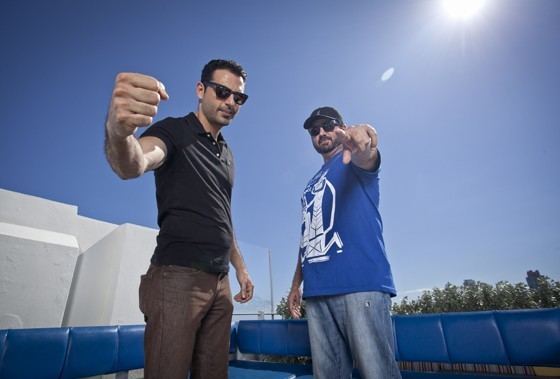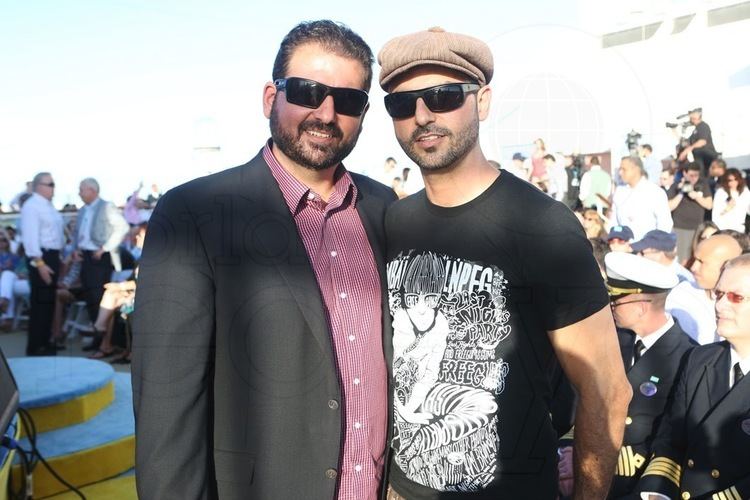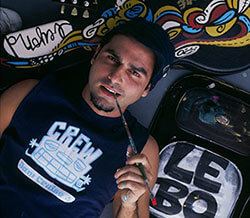Name David Batard | Siblings Dan Le Batard | |
 | ||
Education | ||
David "Lebo" Le Batard: The Art of Invention
David Le Batard (also known by the nickname LEBO) (born November 19, 1972) is a Cuban-American graphic and fine artist based in Miami, Florida, best known for murals, live painting, and sculpture. He has been described as one of South Florida's "most recognizable artists", and "almost an institution" in the art world for his wide range of media, projects, and locations.
Contents
- David Lebo Le Batard The Art of Invention
- Personal history
- Themes and influences
- Works collaboration and commissions
- Support for Arts Education
- References

Personal history

Le Batard was born in New York City in 1972 to Cuban parents. He was raised in South Florida, where he attended the Chaminade-Madonna College Preparatory School in Hollywood, Florida. then Florida International University. Overcoming a lack of support and encouragement from his preparatory school, he entered and won the 1990 Silver Knight Award for art in Broward County, Florida, and later judged that competition. He was a lecturer in residence at the International Museum of Cartoon Art while attending Florida International University, which he graduated in 1995.

He is the younger brother of Miami sportswriter Dan Le Batard. who hosts the radio and television program The Dan Le Batard Show with Stugotz. David occasionally makes appearances on his brother's show despite the fact that he has, by his own admission, never willingly attended a sporting event. He also serves as the show's art director, designing television graphics and its studio at the Clevelander Hotel.
Themes and influences

LeBatard refers to his work as "postmodern cartoon art expressionism". He often depicts musicians and musical metaphors, inspired by street art and Cuban music. His visual style involves "soulful" line-based abstractions against bold flat color backgrounds.
The obvious example in terms of art is the recent example of Shepard Fairey. But I think the cool thing about art, especially if you do public art - and I've done a lot of murals growing up and stuff like that - is that it really is one of the most democratic ways to deliver a message. So whether it's with voting or it's whatever you happen to believe in. We still have the right in this country to go and put an image on the side of a street, where everybody can see it and everybody can have an opinion about it. Nobody needs to pay for it to get something from it, and it engages. And then it’s open to whatever it’s going to be open to, but you can still deliver your message. So I think the role of artist is, is to take whatever it is they believe in, and put it out there so the public can see it.
Some of it should be in the gallery system and the museums, but I definitely think some of it should be available to people that aren’t interested in any of that stuff. Because to me, being an artist you should -- for my method, I'm not saying all artists, but in the way that I try to produce art, and that’s part of the reason I do live stuff too -- you should try to be egalitarian about it, you should try and reach as many people as possible. Because I wouldn’t just want to reach people on a street level either. I like to have my work sometimes in an intellectual forum, where I am able to discuss it and I'm able to validate it and show the thought behind it. As well as put it on the street and have nobody even knows who did it or maybe its signed or whatever but they don’t really know who I am.
- LEBO, 2011 Interview with SensibleReason.com
I think there’s an underlying message in what I do: it's a message of hopefulness. I really try to explore that in as many ways as I can. One main way that I do and that I'm doing now as well is really studying natural principles. So that can be studying botany, or organic science, or astronomy and really trying to extract the things that make us who we are by studying those different things and magnifying those things. The things that make us the same, basically, verses the things that make us different. Which is what I think I spend a lot of time doing. When I in my teens, it was all about, you know, "Well how am I different?" My way of thinking is like this, and these people's way is like that and so forth. So over the years I've kind of had a real strong penchant for philosophy, for the past 15 years. And I think the more I have come closer to that the more I have become interested in the things that make us the same, and particularly the positive things that make us the same, and those are the things I tend to really explore over and over again.
- LEBO, 2011 Interview with SensibleReason.com
Works, collaboration, and commissions
Le Batard's first public exhibit was at Johnson & Wales University in North Miami in 1996, after which he began selling paintings and receiving commissions. He has since exhibited in galleries throughout the United States. His works include a number of murals and other public art installations in Detroit, New Orleans, and South Florida and bicycle racks. A mural he painted for American football star Ricky Williams appeared on television when Williams' home was featured on MTV Cribs.
LeBatard has collaborated extensively with various musicians. He appeared and toured with Thievery Corporation, the Beastie Boys, Bela Fleck, Burning Spear, Disco Biscuits, Cuban band Conjunto Progresso, and Arturo Sandoval, among others, creating live art while the groups performed. He has also designed CD cover art and other artwork for Phish, The Spam Allstars, and the Latin Grammys. He has appeared in Mexico City, New York, Chicago, Los Angeles, and Jamaica for various site-specific art projects, including a trip to the Amazon funded by the Ford Foundation.
LeBatard has been commissioned for commercial art by Bacardi, Adidas, Gibson Guitars, Nestle, Macy's, the Miami Heat, Calvin Klein, "Zoe's Summer Groove", and the Langerado Music Festival.
He has also worked in the media of fabric, aircraft exteriors, cruise ship hull artwork, stained glass, furniture (he collaborated with designer Ralh Pucci, among others), and flower shows. In 2008 he collaborated with an Italian tile manufacturer to design the world's largest mosaic mural in Venice, Italy.
He also painted the hull art of the Miami-themed ship Norwegian Getaway by Norwegian Cruise Line
Support for Arts Education
From a 2011 interview with SensibleReason.com:
In my experience I've never really relied on the government for anything and I don't believe in the government for anything. I think that anything they usually have their hands in kind of turns to shit. So even though it's unfortunate, I don’t think (a) it's a surprise and (b) I don't think they were doing that good of a job to begin with. I've never relied on anything from the government in my art career, and I didn’t go to public school. And even the school that I did go to, they were more private schools for working-class people, so they didn’t have arts programs. So ideally, I think it would be great if we valued art and the resounding effect it can have on our intellect outside of the art world. It’s like learning how to play chess: you know, you may know how to play chess really well, but the advantage comes in that it helps all of your other modes of thinking. And I think art does that too. But to me, this country and the government, they stopped caring about people a long time ago, and art is just one example. We can go down the list - whether it's medicine or even our road systems, they just don’t do a good job. So while it’s disappointing, it's not surprising at all.
